Phil Ross (San Francisco) works in the realm of “biotechniques.” He makes sculptural and architectural works from plants and fungi, and videos about live cultures. As the founder and director of CRITTER – a salon centered-around DIY biology events, he has organized events like “Enormous Microscopic Evening” at the Hammer Museum (2010). His multi-decade research into mushrooms has led to his “mycotecture” series, an experiment in using reishi mushrooms as a sustainable construction material (International Patent Pending). Ross is presently designing and prototyping fungal furniture. His work is part of the touring exhibition, “Intimate Science,” which I curated for Carnegie Mellon’s Miller Gallery, and opens next at Real Art Ways in Hartford Connecticut, November 3, 2012.
ANDREA: In addition to being an artist, you’ve worked in restaurants, in roles from dishwasher to chef; and you’ve also served as a hospice caregiver during the AIDS crisis, where you learned about the benefits of “reishi” mushrooms for the immune system. Did these experiences lead you to working with living materials as an artist?
PHIL: Yes, but I’d go back a little bit further. I grew up in New York City, and like a lot of urban people, I felt highly alienated from nature. I wanted to connect, but I didn’t really know how. The experiences you mention kind of unlocked the “how.” Food and mushrooms were the materials that were in my proximity, so they were the entry point. It became apparent to me that you can connect to nature through pretty much anything or any kind of activity that’s close to you.
ANDREA: Where did you work as a chef?
PHIL: One of the places I worked for four or five years was in upstate New York, at this place called the Omega Institute, which is a kind of a new age retreat center. I spent part of the year there, and in San Francisco, and also traveling around the world. It was at Omega that I was introduced to mushroom hunting from some of the other chefs. It’s in the Hudson Valley and there are all these hardwood forests around there, making it a great habitat for mushrooms.
ANDREA: I think it’s interesting how you describe mushroom hunting as “an esoteric skill” that “bridges delicacy and poison.”
PHIL: Yeah. If you learn to motorcycle race, there’s that tension of having to know what you’re doing and remain in control. I’m not a high testosterone kind of person like that, but I still enjoy the notion of a real world education– and the threat of death is a pretty good one. Choosing the right mushroom is not a theoretical proposition; you have come to a place of certainty, not through posturing, but actually knowing. It’s partially about sensation, but it’s also a science.
ANDREA: At what point did you have the impulse to start working with mushrooms, not as food or medicine, but as a sculptural material?
PHIL: It was when I started to learn how to grow mushrooms. The initial impulse was to figure out how to grow reishi mushrooms as medicine, but when I started cultivating them and learned their growth habits, I immediately wanted to work with them as an art material– a casting material. It was a casting material that could be altered as it was setting. In casting, the amount of time you can work with the material before it sets is called “open time.” In plaster that might be five minutes, and in cement it might be a couple hours. But with mushrooms, the open time is almost as long as you can keep them alive. You can start to think about plasticity and forming things through much more subtle encouragement. The shapes can be controlled via the environment: the temperature, the position in relation to gravity, all these things that we take for granted, but are profound shapers of the world. You can begin to play with these factors and use them as non-physical tools of manipulation. Light, gravity, heat and the cleanliness of the environment determine the form, as opposed to a chisel or a drill or something like that.
ANDREA: So you were “casting” mushrooms in your studio? And how did you maintain a sterile, laboratory-like environment in a domestic space?
PHIL: I knew how to do canning and beer making, and the techniques involved in mushroom growing aren’t all that different. And then I ultimately learned how to build air filters (a really critical aspect was creating clean air). Off-the-shelf laboratory air filters are ridiculously expensive, and so is much of the other commercial equipment you need to do this, so I created my own.
ANDREA: Was it trial and error, or were there particular sources of information that you used as reference?
PHIL: It was pre-Internet, you know. So, the resources I had were primarily books, clubs, individuals, and trial and error. And a lot of people who grow mushrooms are kind of secretive; it’s not the most open culture. I think it just began to be practiced here in the Bay Area in a more open way maybe before other places because of the culture of open-source and a particular history of political/environmental activism.
ANDREA: There’s a lot of secrecy that surrounds mushroom practices? Why is that?
PHIL: Partially because of the history. It was usually a family practice, proprietary knowledge, handed down.
ANDREA: Similar to guarded recipes?
PHIL: Yeah, a closely guarded secret. And if you can do stuff with mushrooms you can certainly make a good profit; you have a proprietary organism that you’re creating. As a field, it has been very closed. Probably because of Paul Stamets’ books the field has opened up quite a bit more. And the Internet has disseminated information to hobbyists, and mushroom growers.
Also, technologically, there was the trickle down effect of the Hepa filter becoming cheap and distributed, a gateway technology that opened up the field.
ANDREA: Who was the author that you mentioned?
PHIL: Paul Stamets. He’s written a number of books on growing gourmet and medicinal mushrooms and took a lot of this very secretive knowledge, codified it and explained it. He wrote a number of books that became the recipes for a lot of people. And they were certainly good guides for myself as well. They were advanced, but they were clear, in terms of how to render stuff.
ANDREA: So this mushroom research started for you in 1996?
PHIL: I think so, yeah, about that time.
ANDREA: So you were saying at that time that most of the knowledge that you acquired was through books or through trial and error and experimentation. But now you find there’s a whole universe that’s opened up online?
PHIL: Oh God, yeah. It’s phenomenal. The cat’s out of the bag. I mean it’s too much for me. It feels overwhelming. It feels like you could do almost anything at this point, there are so many resources.
ANDREA: But has the openness helped your practice or do you see it as something that is superfluous?
PHIL: Things are doable now that are only limited by the imagination, or money. There are so many people doing stuff with mushrooms right now. It felt lonely for a while being this insulated mushroom weirdo, so in some ways it’s a huge relief. Right now there’s just a profusion of mushroom stuff that crosses over between practical technology and the fantastic. In terms of what I’m doing, I’m in some weird graduating point between this DIY artistic person and entering into an incorporated venture. I’ve made the transition between hobbyist into something like an actualist.
The other day I was looking through some recently scanned Google books and I found obscure bits of knowledge from textbooks that were published in the ’60s and the ’40s. Books that had something like a thousand published volumes. They were mainly housed in libraries in agricultural colleges and places like that and now these books are online.
You can start to look at texts and to assemble things in ways that you never could before. The people who run fungal genetics labs right at this moment are looking at the same information that I’m looking at. It’s like having these brand new libraries with the doors wide open and everybody’s wandering in. And we’re just at the beginning of this enormous process. It feels kind of unbelievable.
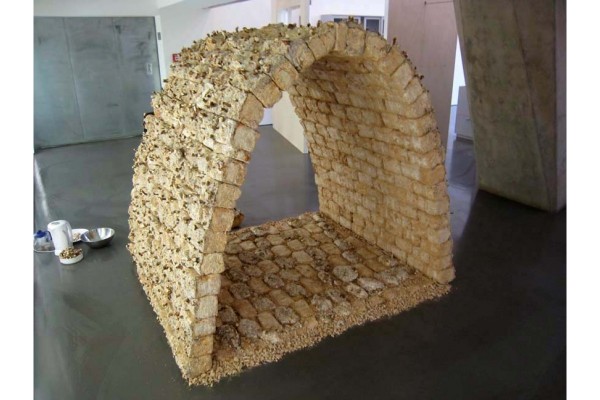
Mycotecture Alpha (2009) A very literal teahouse made of reishi mushrooms and boiled down into tea that was served throughout the course of the exhibition, “Eat Art,” at Kunsthalle Düsseldorf.
ANDREA: And how do you fit in among mycologists, for instance? Do they see the work that you do as relevant to their work? Do they see it as part of their universe, or is it seen as a curiosity, or a threat?
PHIL: It depends who you ask. Yes to all of those things. [Laughs] I’m just doing my thing. I certainly evolved out of my interactions with the Mycological Society of San Francisco; I have been a regular staple at the Fungal Fair that they’ve held here over a number of years. I’ve worked with their Cultivation Committee, and I’ve taught a number of workshops around the Bay Area. I’ve gone and talked to other Mycological Societies around the US. They seem to welcome it. Like, how much sexy mushroom news is there? My work is very good for teaching the science of the mushroom’s life cycle and growth; you can actually show the mycelium with the fruit growing right off it. I often use these mushroom samples as my calling card quite, as a way to talk to research scientists and other folks who are involved in myco studies. They all seem to like it. But, I don’t know what its position is or even if it has one.
ANDREA: How do you introduce yourself? Do you introduce yourself as an artist or a researcher, or a mycologist?
PHIL: I’ve found that familiarity with the language is often the passport for access more than what I call myself. And not just for the mushroom movement. You can introduce yourself anyway you like if you have the sophistication of vocabulary. I think that a common language becomes the way of entering into any community. When I first started doing this work I sounded like a crazy person, cold calling people and saying, “Hi, I want to work with your oyster farm for four years to grow a structure.” And a lot of people just hung up or said, “What are you talking about?”
The models I make are a means of introducing myself as well, as are the drawings. If you know how to draw or make something that looks enticing, or interesting, then suddenly people will listen to your idea in a way they otherwise might not. Having the illustration along with the words becomes very powerful. The same way that comic books have text and image together to convey something greater. So it’s pushed me to continue to draw and make models because they become the entry point, for no matter how crazy an idea, it appears real in people’s minds.
ANDREA: We’ve been talking about access to information and processes, and the increased level of transparency that the Internet has provided. But at the same time, you’ve been at this for 16 years, so you could have multiple degrees in biology and mycology at this point. I find your emphasis on being conversant and speaking the same language as a critical argument. You’ve worked your way to that point. I’m sure the first years you were operating; you probably met quite a bit of rejection.
PHIL: Yes, quite a bit. (Laughs). At this point my history is my passport as well, and I can point people to my website. And people can then explore my work at their own leisure and pull whatever they need to out of it. It can be a bit overwhelming to get some of these concepts across. “Hi, you don’t know me but I’m just gonna introduce my, my program now, which is intense!” How do you bring the short version of that to a person? Just being able to say, “Hey, go check out my website” is a bit less daunting. And then they can take or leave as much as they want to. And then usually after they’ve looked at my previous work they find some point of interest, and we can start a conversation there. At this point the world seems more interested in biological projects like this, too.
ANDREA: One of the things that I really like about your work is that it operates on many levels. You’re doing materials research, you’re making fine art: drawings and paintings, and you’re building prototypes. The works that need the most explanation to me are the sculptural works that are the actual mushrooms that you’ve forced to grow into unusual configurations through controlling their environment. It’s not physical sculpting; it’s almost like psychic sculpting. You give them low levels of oxygen, high concentrations of CO2, it seems almost like mushroom torture.
PHIL: Yeah. Increase the oxygen or give them more gas. Control the regulatory system. I guess a lot of artists are like, “I’m just painting what I see.” But these [environmental] technologies are all around us and they are absolutely what enable us to do so much of what we do. Right now I’m inside of a cave on a hillside that has an HVAC system, lighting, a thermostat, and all the same kind of stuff that allows us to inhabit interior spaces. I feel a sense of being in vitro or inside of a larger control system. Yes, you can rage against the machine, but it seems like the machine is everywhere. And I don’t know if raging against it is the best position necessarily. Maybe it’s better to assume the leverage of control of oneself. That’s how I think about the psychological aspect of it all.
ANDREA: I just see your “Pure Culture” sculptural works as very wild looking, and yet they are rigorously controlled.
PHIL: That’s the beauty of it for me. Some of the sculptures I grow that are the most grotesque looking are the subtlest in terms of their demonstrations of control. That’s why a very great aesthetic teaching experience has been learning about penjin and the traditions out of which things like bonsai and scholar stones evolved. In these Eastern traditions there is a notion of how biological technique was applied to a greater knowledge of the larger environment around oneself. The fungus that looks like some weird sea organism, some cancerous growth, or something like that, those took sometimes the longest to grow. Keeping the organism in this exquisite nowhere zone, between a lot of different states, so it would grow in such an abnormal fashion. That grotesqueness or the uniqueness of it is part of the connoisseur’s eye you could say, “That’s not just a turd on the side of the road; that’s a excellently formed fungal artifact.” It has to do with how one discerns the environment. The “Mycotecture” bricks are obvious about recording the control system they’ve been pushed through. With the more organic looking ones, the artifice is elevated further, but it somehow looks more natural. To me, that’s what makes them really interesting.
ANDREA: And it can take up to a year to achieve those results?
PHIL: Yeah, sometimes even longer. The fungal fruit that are grown into geometric steps and things like that, took even longer, like two or three years to come into being. But, the bricks are actually very rapid. They can be done in as little as a week.
ANDREA: And you’re still growing them with the Far West Fungi mushroom farm?
PHIL: Yeah we’ve been doing a bunch of stuff together.
ANDREA: And you’ve applied for a patent for mushrooms as a sustainable, non-toxic building material?
PHIL: I applied for a patent in November 2011. There is an international patent pending. I actually would like that mentioned. (Laughs).
ANDREA: I will definitely mention that!
PHIL: I feel like I’ve conjured this thing by making drawings and doing the actions and going through the technique. And then all of a sudden, people seem to think that there’s gold in the object. It has the potential to be a substitute for many petroleum-based plastics. It’s left the art world and seems to have entered a Science Fiction novel or something like that. I’m not really a good capitalist but I also feel like “being a corporation” is a fascinating system to be within. With this stuff it’s possible to go into regional production of biomaterials. For instance, here in San Francisco, we could start producing lots of local materials using this fungus and could create a pilot project of sorts. There are so many ways that this technology can be used at this point so I’m just looking around and trying to get good advice, and figuring out what one does with something like this. I feel like I’m on a rocket and I’m holding on. I’m like, “What the hell?”
ANDREA: I can’t imagine that many artists have been in this situation, but rather people who consider themselves inventors. It is interesting you mentioned a possible visit from some big corporations because the last exhibit I curated, “29 Chains to the Moon,” which was much more fantastic and speculative, included a proposal for an open source “sea stead” (a homestead at sea) by an artist named Cesar Harada, who is now designing oil spill cleanup drones. But we had a US Navy “think tank” fly in to see his work. That was both thrilling and terrifying because of what it could potentially mean for this person’s intellectual property.
PHIL: My experience with open science is that it is kind of like the Wild West. It’s not just for weird, creative individuals, but large sectors of practice having to do with technology and science have been scrambled. It’s like everybody’s now trying to figure out how to pick it all up and put it together into whatever it’s becoming. I went to the Open Science Summit here about a few months back and there were these people who sounded like anarcho-Libertarian radicals, but they were the directors of Drug companies and Insurance companies. And they were saying things like, “We are on the verge of making a trillion zillion dollars through Open Source and Open Network means of solving problems. We have to destroy capitalism as we know it because otherwise we’re not gonna make as much money.” It was just such a weird inversion. And there are a lot of people realizing just how much potential there is in these new kinds of network situations.
ANDREA: Wow. That’s a whole chapter for discussion. But let’s talk about the models. Your models seem to be the more extrapolative works– more fantastic. They have a kind of fleshy look to them that is distinct from the sculpture and the fungal bricks.
PHIL: Yeah. They’re more organ-y looking, more biological. So much of the process of growing this structure is in the way that it comes into being. Which is true with any kind of building. And so as the fungi are growing, it’s like something from Invasion of the Body Snatchers. These things are wet, and gooey; they’re exuding things, they change colors, they grow warts. They go through this rather fantastic kind of transformation and it’s hard to translate that for people who aren’t used to thinking about a bag of goo as an actual engineering material. Usually it’s plastic, or metal, or these very beautiful homogeneous kinds of textures… surfaces. But this is definitely a living thing, and it goes through all these physical and aesthetic transformations as it grows. I wanted the models to look something like they do as they’re growing in the studio.
ANDREA: Before we got on the phone, I was looking online at fungal research, and I came across the National Fungal Culture Collection of India. There seems to be a lot of mention of mycology in India, maybe you’ll know why. But this is actually a new institute that’s been created to conserve fungal samples because apparently there are certain species of fungi that are disappearing altogether. Do you know about this?
PHIL: Sure. In general it has to do with deforestation and climate and environmental change. Just the volume of truffles that is collected each year has been reduced enormously over the past century. A boat about the size of the QE2 used to bring truffles over to the United States. And these days, there are maybe the size of a garbage barge. There are way fewer wild truffles on the planet. As you get rid of trees and environments you also get rid of the fungi that have adapted to them as well; they’re very sensitive to that kind of stuff, and will often have relationships to specific plants and the environments where they grow. There isn’t a very good sampling of world fungi, or even identification. It’s thought that only less than 10% of the macroscopic fungi have even been identified.
ANDREA: Talking about deforestation, and the loss of even medicinal fungi, is a good place to close. But, is there anything else that you want to cover?
PHIL: I’ve done a ton of engineering tests this past year as part of the patent process to figure out what makes fungi grow stronger or not. And to all accounts it seems like you can use this process in a host of different applications, ranging from the more pedestrian things like furniture or building materials but even up to such far out applications as growing fungal shapes to grow human organs within, or organic batteries or even computers. So it can kind of become a lot of things. It’s sort of like a plastic that can potentially be used for God knows what.
ANDREA: We just watched The Graduate with our daughters who are probably too young to watch it. But I just imagine the father’s friend offering advice to Dustin Hoffman as, “I want to say one word to you. Just one word. MUSHROOMS.”
PHIL: Yes, mushrooms. I get approached by a lot of undergraduates and graduate students in biology, biotech, or in environmental science, and they’re looking for direction. I tell them, “The future is fungal.”


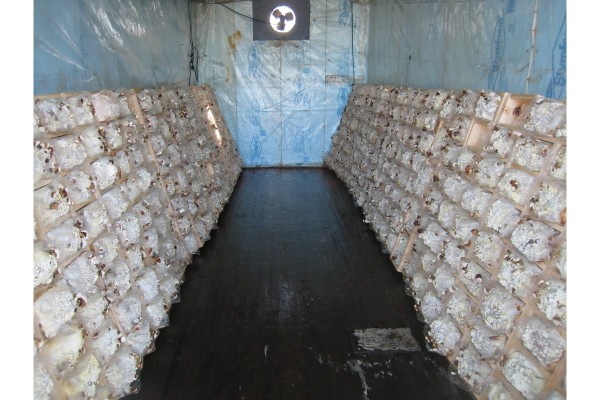
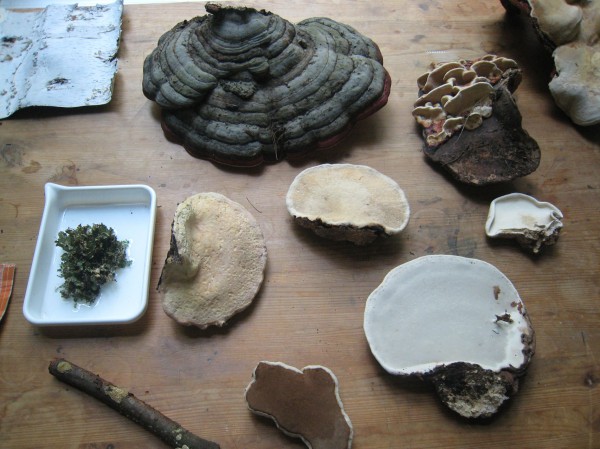
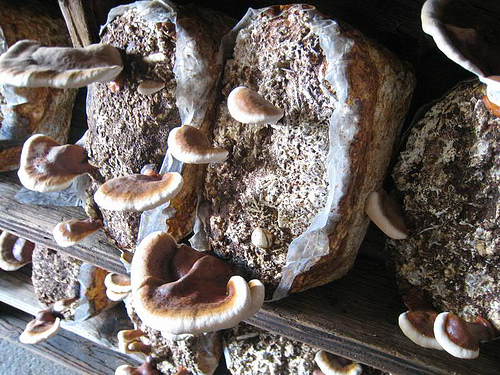
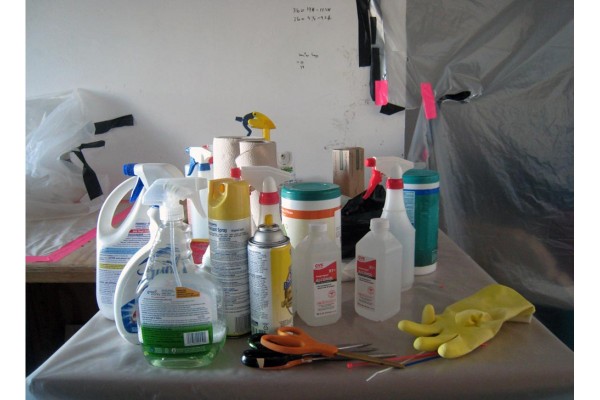
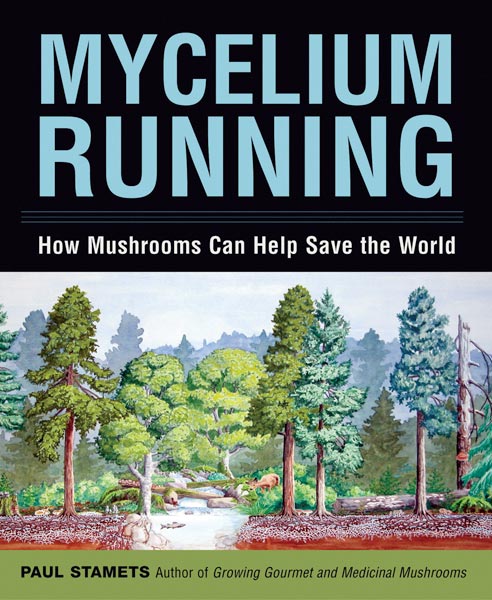
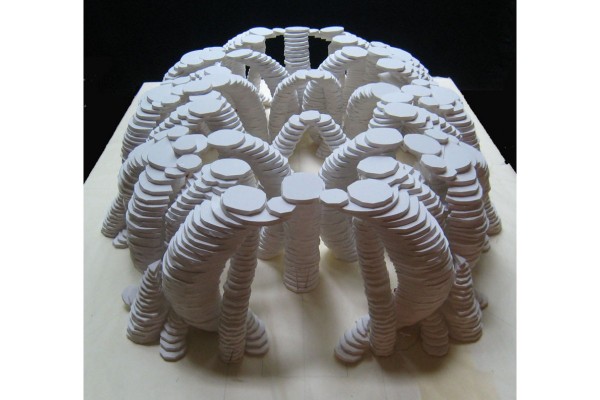

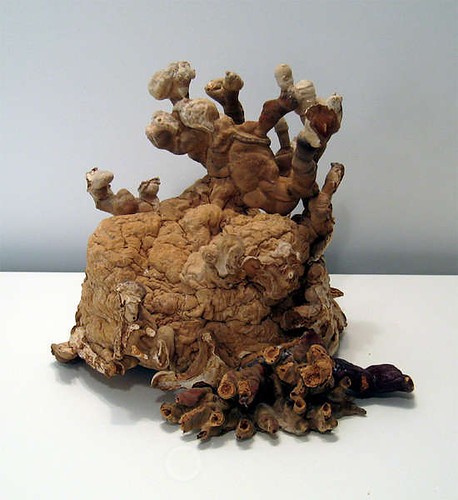

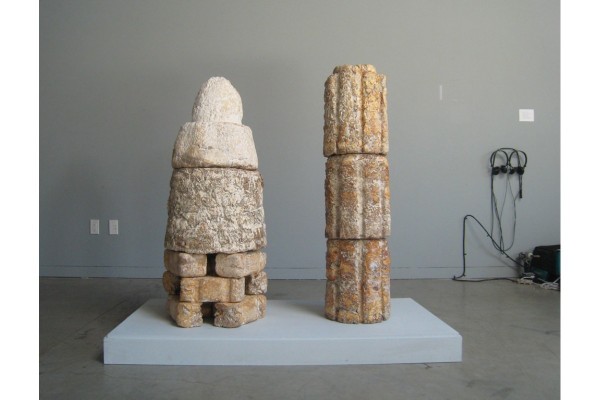
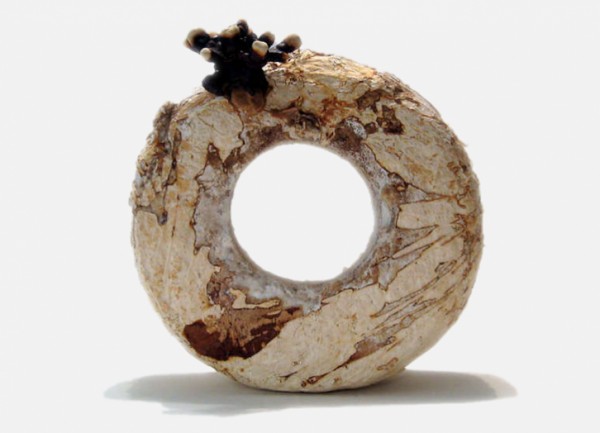

5 comments
I enjoyed this article very much! Thank you to Mr. Ross and yourself for sharing this wonderful and informative research with interested parties such as myself! I feel re-inspired by this work and concept!
Really nice work, very innovative, thanks for sharing this research, any details on the structural strengths of these blocks?
Beautiful! Thank you for your inspiring www-sites. Can this fungal material be 3D-printed/growed? They already have eco-friendly printing materials as salt, and 3D-printed whole houses in Amsterdam…. just thinking. I wish to grow my own house out of this material some day.
Very thorough article – thank you for sharing! I was also wondering if there has been any structural testing of this material. I have read in multiple articles that it is stronger (per pound) than concrete, but I haven’t seen any actually range per process of growth.
They own a patent on how to grow mushrooms? This patent nonsense is getting out of hand. They will own a patent for water and air at some point. If you can’t pay you’ll die. People have to go open source with as much as possible otherwise we look ahead for a grim future.